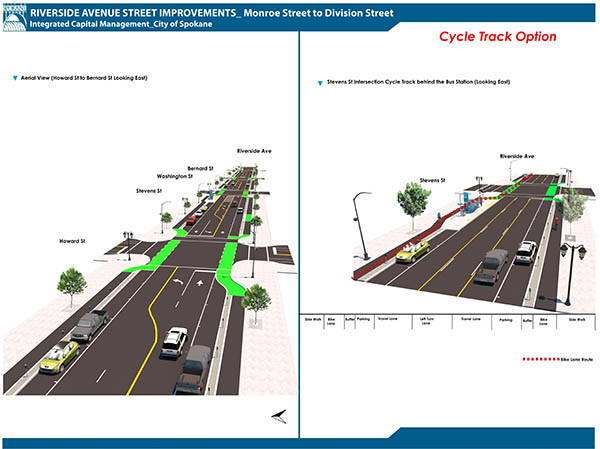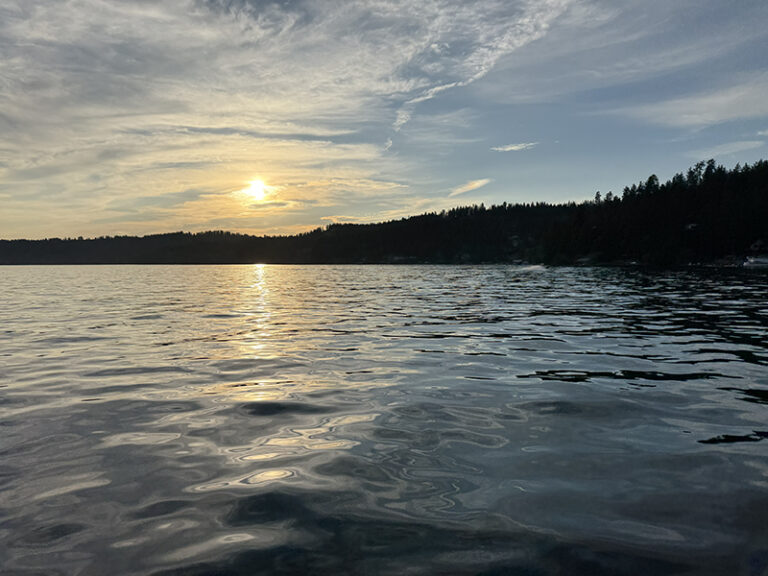In a recent comprehensive ranking of the best cities in the U.S. for riding a bicycle, peopleforbikes.org placed Spokane at the bottom of page 8. Its rating was of 1.6 out of 5, in the seemingly unsavory company of such underachieving cycling cities as Reno, Nevada; Casper, Wyoming; and Little Rock, Arkansas. The categories for evaluation included Ridership, Safety, Network, Reach, and Acceleration—the latter referring to the rate at which each city is improving its cycling infrastructure.
Acceleration may be the way Spokane achieves the level of bike-friendliness of four-season leaders like Madison, Wisconsin, and Fort Collins, Colorado, which scored 3.5, the highest overall ranking given to a U.S. city. Several local projects are poised to impress fair-weather and whiteout riders alike and to increase ridership by making streets feel safer for cycling.
“We are going to grow—we need to focus on all kinds of transportation to accommodate that growth. I’m trying to get [the city] to do innovative things,” noted Councilwoman Kate Burke regarding her advocacy of such potentially polarizing ideas as protected, or “Dutch” intersections. These types of automobile/bicycle traffic crossings would be among the first of their kind in the U.S. Protected intersections incorporate refuge islands, road markings allowing cyclists to stop ahead of cars, and traffic light prioritization for cyclists. Proposals to rework intersections alongside physically buffered bike lanes on Riverside Avenue from Howard Street to Bernard Street, are being evaluated by the city now, along with more conventional options such as incorporating bike lanes and markings painted on the street.
Bold proposals like these are one avenue toward a safer, more inviting cycling cityscape, but as Burke points out, “What are our 10-year plans if they’re not connecting existing infrastructure?”

As if in response to her rhetorical query, the Cincinnati Greenway, a project of three Gonzaga School of Engineering students and their professor, will connect plenty of existing infrastructure and surely prove another cycling showcase for the Lilac City. Spokane’s inaugural greenway, mostly-funded and breaking ground next year, will connect the Centennial and Ben Burr trails with existing bike lanes on North Addison Street to the Downtown Bike Network. The project will utilize vehicle speed mitigation measures like bump-outs, small traffic circles, and lights at arterial crossings. Additionally, bicycle advisory lanes wide enough for only one car, which must yield to bikes, will line up to 40% of the 1.7-mile corridor, prioritizing people-powered travel and providing the requisite disincentives that keep most car traffic relegated to arterials.
Evidence of the city’s commitment to quadrupling bicycle ridership and tripling its mode share by 2036, goals outlined in its Bicycle Master Plan, comes in forms aside from concrete and paint: a partnership between the City of Spokane and Lime, a trial bike and scooter sharing program that has been underway since Sept. 4 and will run through October and possibly into November depending on weather. Silicon Valley-based Lime has participated in similar programs in San Francisco and Portland, garnering mixed reviews.
In just over a week of operation in Spokane, Lime’s electric-assist bikes and scooters were ridden 5,000 miles in 10,000 trips, according to KXLY.com and seem to be positively received by residents and users for the most part. However, a recent article in the Spokesman-Review cited the concern that Spokane’s new e-bikes “don’t face the same watery fate” as the lilac bikes of the late 90s, many of which ended up at the bottom of the river. Lime bikes cost $1 per half hour, and can be left anywhere in town that is accessible to other users.
The City of Spokane has also alluded to a highly desirable connection between the Fish Lake and Centennial trails. A feasibility study in 2019 will rate several potential alignments, and public comment will be invited. If you’ve ever wondered why two such complementary trail assets in Spokane’s burgeoning bike scene haven’t been brought together yet, or you missed a chance to weigh in on the radical Riverside design options, next year you can vote with your voice. Your input is essential to the design process, welcomed by your councilperson, and appreciated by cyclists throughout the city and region who share your desire for safe, supportive, connected, and convenient bikeways.
Justin Skay doesn’t ride every day, but when he does, it’s invariably in an everyday fashion. His last column was about the potential of bike fitting to improve your performance.













